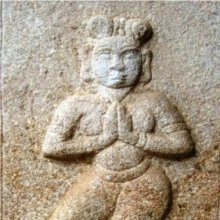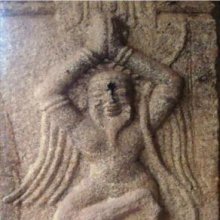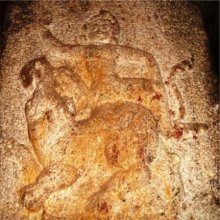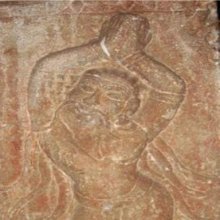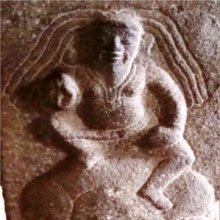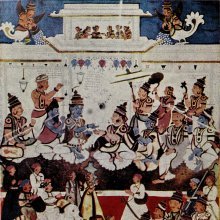Shrirangam, Śrīraṅgam, Shri-rangam: 2 definitions
Introduction:
Shrirangam means something in Hinduism, Sanskrit, the history of ancient India. If you want to know the exact meaning, history, etymology or English translation of this term then check out the descriptions on this page. Add your comment or reference to a book if you want to contribute to this summary article.
Images (photo gallery)
(+6 more images available)
In Hinduism
Vaishnavism (Vaishava dharma)
Source: Acta Orientalia vol. 74 (2013): Historical sequence of the Vaiṣṇava DivyadeśasŚrīraṅgam (Araṅkam) refers to one of the 108 Vaishnava Divya Desam (divyadeśas or divyasthalas), located in the topographical division of Cōḻanāṭu (“Chola country”), according to the 9th century Nālāyirativviyappirapantam (shortly Nālāyiram).—Tradition would record the Vaiṣṇava divyadeśas or divyasthalas are 108. The divyadeśa is a base of the cult of Viṣṇu in Viṣṇuism [Vaiṣṇavism] tradition. The list of 108 [viz., Śrīraṅgam] seems to have reached maturation by about the early 9th century CE as all the deśas are extolled in the hymns of the twelve Āḻvārs.

Vaishnava (वैष्णव, vaiṣṇava) or vaishnavism (vaiṣṇavism) represents a tradition of Hinduism worshipping Vishnu as the supreme Lord. Similar to the Shaktism and Shaivism traditions, Vaishnavism also developed as an individual movement, famous for its exposition of the dashavatara (‘ten avatars of Vishnu’).
India history and geography
Source: What is India: Annual Report on Indian Epigraphy (1945-1952)Śrīraṅgam is an archaeologically important site situated in Tiruchirappalli-taluk (Tiruchirappalli district, Madras), known for inscriptions regarding the ancient history of India. For example, at Śrīraṅgam there is a Tamil inscription which seems to record the gift of a village as sarvamānya by a Mahāsāmanta (name lost) to the deity on the occasion of an eclipse. It is dated Śaka 1392.
There is another Tamil inscription at the Raṅganāthasvāmi temple, second prākāra, south side, wall of the jewel room facing the south wall of the Chandanamaṇḍapa. It registers a gift of land by Veṅkaṭappa-Nāyaka of Chandragiri, son of Achyutappa and grandson of Nāgappa, for several offerings to god Raṅganātha. Mentions Vīrappaṇa-Uḍaiyār. This inscription belongs to king Veṅkatapatideva Mahārāya (I) of the Vijayanagara dynasty and is dated Śaka 1510.

The history of India traces the identification of countries, villages, towns and other regions of India, as well as mythology, zoology, royal dynasties, rulers, tribes, local festivities and traditions and regional languages. Ancient India enjoyed religious freedom and encourages the path of Dharma, a concept common to Buddhism, Hinduism, and Jainism.
See also (Relevant definitions)
Partial matches: Shri, Rankam.
Starts with: Shrirangamahatmya, Shrirangamallastotra, Shrirankam.
Ends with: Shrirankam.
Full-text (+26): Ranganatha, Ranganathaswamy, Ranganathar, Shriranga, Shriranganatha, Shri Rangam, Vasudeva, Arankam, Tirumanga, Dhanvantari, Adinarayana, Irankecan, Arankecan, Alakiyamanavalan, Dasharatha, Rankanatan, Tiruppanaḻvar, Arankanatan, Shrirankam, Colanatu.
Relevant text
Search found 32 books and stories containing Shrirangam, Śrīraṅgam, Shri-rangam, Śrī-raṅgam, Srirangam, Sri-rangam; (plurals include: Shrirangams, Śrīraṅgams, rangams, raṅgams, Srirangams). You can also click to the full overview containing English textual excerpts. Below are direct links for the most relevant articles:
Kashyapa Shilpa-shastra (study) (by K. Vidyuta)
1. Conclusion (Prākāras) < [Chapter 6 - Conclusion]
3. Conclusion (Gopuras) < [Chapter 6 - Conclusion]
The Bhagavata Purana (by G. V. Tagare)
Chapter 79 - Balvala Killed: Balarāma’s Pilgrimage < [Book 10 - Tenth Skandha]
Part 5 - Commentators on the Bhāgavata Purāṇa < [Introduction]
Siddhanta Sangraha of Sri Sailacharya (by E. Sowmya Narayanan)
A History of Indian Philosophy Volume 3 (by Surendranath Dasgupta)
Part 2 - Rāmānuja < [Chapter XVIII - An Historical and Literary Survey of the Viśiṣṭādvaita School of Thought]
Part 5 - The Influence of the Āḻvārs on the followers of Rāmānuja < [Chapter XVIII - An Historical and Literary Survey of the Viśiṣṭādvaita School of Thought]
Part 3 - The Precursors of the Viśiṣṭādvaita Philosophy < [Chapter XVIII - An Historical and Literary Survey of the Viśiṣṭādvaita School of Thought]
Middle Chola Temples (by S. R. Balasubrahmanyam)
Temples in Kottamangalam < [Aditya I]
Raja Mahendra (a.d. 1060-1063) < [Chapter V - Successors of Rajendra I (a.d. 1018 to 1070)]
Related products
